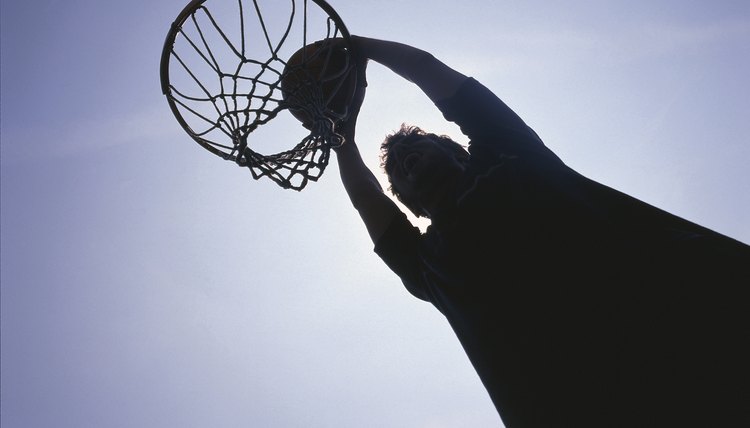Starting Up Basketball Again After a Long Break

Getting back into basketball shape after a layoff requires different types of exercises and workouts, in sequence, to help create the physical attributes you’ll need to perform at your best. Although basketball is a quick, high-intensity sport, your training should start slowly and build to more game-like training over weeks or months.
Basketball Fitness
Basketball requires an aerobic base to sustain a high level of play for multiple hours, but your quick movements are created using your anaerobic energy system. You will need cardiorespiratory stamina, muscular endurance, explosive and reactive power, speed, quickness, agility, balance, vertical leaping ability and the ability to catch your breath after sprints. To build these attributes, you will need to use different training methods. Break your training into three phases that help you build muscle strength and aerobic stamina, then explosive power and muscular endurance, finishing with speed, agility and anaerobic fitness.
Phase 1
As you begin your basketball conditioning program, strength training should focus on muscle building. Use a 3 x 5 workout, which consists of performing five repetitions of an exercise per set, and three sets of each exercise per workout. Use 60 percent to 70 percent of the maximum weight you can lift, and take a short break between each set. Perform cardio exercises at the highest intensity you can sustain for 30 minutes or more. This might mean brisk walking on a treadmill, rather than jogging or running, if you can’t jog or run for 30 minutes. Your goal is work longer so you can improve your stamina, or ability to work longer. Start your workouts with strength training to use up stores of glycogen, which will result in better fat burning when you begin your aerobic exercise. Increase your weights and cardio speeds each week as you improve your conditioning. Include core exercises in each workout.
Phase 2
After several weeks or months of strength and aerobic training, depending on how much time you have before your season starts, decrease your loads and increase your volumes, or work in shorter, higher-intensity sets. This will help you build cardio capacity, muscular endurance and anaerobic conditioning. Use about 50 percent of the maximum weight you can lift for muscular endurance exercises, and perform reps for 30 to 90 seconds. You can also use calisthenics to build muscular endurance, including pushups, pullups, dips, chinups, burpees, mountain climbers and core exercises. Add explosive exercises that require a powerful move in one direction. Include box jumps, box squats, deadlifts and one-leg, split-squat jumps. Add intervals of high-speed sprints to cardio workouts, followed by slow recovery periods. Use a 1:3 work/recovery ratio. Begin working on your on-court shooting, dribbling and passing skills, focusing on technique and repetitions. Do not fatigue your muscles by shooting the same shot dozens or more times in a row, which never happens in a game.
Phase 3
One to two months before your season starts, depending on how long you have for pre-season training, end your aerobic work and focus on sprint training, creating 15-minute interval workouts. For example, sprint the length of a basketball court, then walk back. Repeat this six to eight times, depending on your conditioning, before moving to a different interval exercise. Add footwork and agility drills that make you move in many directions, similar to a basketball game. Use a rope ladder, cones and short hurdles. Add plyometric drills that emphasize jumping. Perform depth jumps, 1-2-3 jumps, standing broad jumps, jump squats and reactive squats. Continue working on your on-court shooting, dribbling and passing skills in game-like situations.
References
Writer Bio
Sam Ashe-Edmunds has been writing and lecturing for decades. He has worked in the corporate and nonprofit arenas as a C-Suite executive, serving on several nonprofit boards. He is an internationally traveled sport science writer and lecturer. He has been published in print publications such as Entrepreneur, Tennis, SI for Kids, Chicago Tribune, Sacramento Bee, and on websites such Smart-Healthy-Living.net, SmartyCents and Youthletic. Edmunds has a bachelor's degree in journalism.
